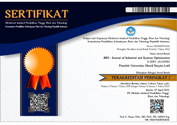Perancangan Ulang Tata Letak Gudang Produk Menggunakan Metode Dedicated Storage (Studi Kasus: PT. Borneo Indah Fokus, Samarinda)
DOI:
https://doi.org/10.51804/jiso.v5i1.61-67Keywords:
assignment, dedicated storage, gudang, material handling, relayoutAbstract
Gudang adalah fasilitas atau sarana pendukung dalam kegiatan operasi industri yang berfungsi untuk menyimpan bahan baku ataupun produk jadi. Kondisi Gudang PT. Borneo Indah Fokus, Samarinda saat ini adalah pengaturan produk yang tidak rapi serta tidak memiliki slot/blok penyimpanan khusus pada masing-masing jenis varian produknya sehingga hal ini menyebabkan jarak tempuh (distance traveled) pada aktivitas kegiatan material handling menjadi sangat besar dan waktu bongkar muat menjadi lebih lama. Penelitian ini bertujuan untuk merancang ulang tata letak (relayout) serta memberikan usulan perbaikan tata letak Gudang dengan mengurangi jarak tempuh, mengurangi waktu bongkar muat dan spesifikasi pada setiap slot/blok. Metode dedicated storage digunakan untuk menempatkan jenis varian produk ke slot/blok penyimpanan yang lebih spesifik. Metode dedicated storage berdasarkan pada perbandingan aktivitas throughput dan storage (T/S) dengan menempatkan T/S tertinggi pada slot/blok dengan jarak antara setiap slot/blok dan I/O point terkecil. Terjadi perubahan penempatan (Assignment) produk setelah dilakukan perbaikan, waktu bongkar muat pada kondisi gudang awal dan usulan memiliki selisih 33,069 jam dengan nilai efisiensi sebesar 69,231%. Jarak perjalanan total (distance traveled) berkurang 11.172,75 meter dengan efesiensi 65,062%
ABSTRACT
Warehouse is a facility or a supporting infrastructure in industrial operations which function to storage raw materials or finished product. Current state of Warehouse PT. Borneo Indah Fokus, Samarinda is unkempt product arrangement they also didn’t have a slot / block specialized storage on each variant product so it makes the distance traveled of material handling activity become harder and the loading activities become longer. This research was aimed to redesign the warehouse layout (relayout) and give a proposed improvement of warehouse layout to reduce distance traveled, reduce the loading time and specification on each slot / block. Dedicated storage method used to put a variant product to their specific slot / block based on their throughput activity and storage comparison (T/S) by placing the T/S highest slot / block with the distance between each slot / blocks and the smallest I/O point. There was a change in the Assignment of the product after repair are made, the loading time in the initial warehouse condition and the proposal had a difference of 33,069 hours with an efficiency value of 69.231%. Total travel distance (distance traveled) reduced by 11,172.75 meters with an efficiency of 65.062%
References
Anjos, M. F., & Vieira, M. V. C. (2021). Engineering Applications of Facility Layout (pp. 89–107). https://doi.org/10.1007/978-3-030-70990-7_6
Apple, J. (1990). Tataletak pabrik dan pemindahan barang. ITB Press.
Bandyopadhyay, S. (2019). Facility Layout. In Production and Operations Analysis (pp. 117–157). CRC Press. https://doi.org/10.1201/9781351113670-7
Burhanudin. (2019). Analisis Perbaikan Terhadap Tata Letak Gudang Produk Jadi Pt Spm Dengan Menggunakan Metode Dedicated Storage. JISO : Journal of Industrial and Systems Optimization, 55–61. https://doi.org/10.51804/jiso.v2i2.55-61
Fumi, A., Scarabotti, L., & Schiraldi, M. M. (2013). Minimizing Warehouse Space with a Dedicated Storage Policy. International Journal of Engineering Business Management, 5, 21. https://doi.org/10.5772/56756
Heragu, S. S. (2022). Facilities Design 5th Edition (5th Editio). CRC Press. https://www.taylorfrancis.com/books/9781498732901
Hojabri, H., & Miandoabchi, E. (2013). Facility Layout Planning. In Graph Theory for Operations Research and Management (pp. 212–223). IGI Global. https://doi.org/10.4018/978-1-4666-2661-4.ch015
Husin, S. (2020). Perbaikan Tata Letak Gudang Produk Jadi Dengan Metode Dedicated Storage Digudang PT. YYZ. JISO : Journal of Industrial and Systems Optimization, 8–15. https://doi.org/10.51804/jiso.v3i1.8-15
Olivia Audrey, Wayan Sukania, & Siti Rohana Nasution. (2019). Analisis Tata Letak Gudang Dengan Menggunakan Metode Dedicate Storage. Jurnal ASIIMETRIK: Jurnal Ilmiah Rekayasa & Inovasi, 1(1), 43–49. https://doi.org/10.35814/asiimetrik.v1i1.221
Prasetyo, Y. T., & Fudhla, A. F. (2021). Perbaikan Tata Letak Fasilitas Gudang Dengan Pendekatan Dedicated Storage Pada Gudang Distribusi Barang Jadi Industri Makanan Ringan. Jurnal Teknik Industri: Jurnal Hasil Penelitian Dan Karya Ilmiah Dalam Bidang Teknik Industri, 7(1), 1. https://doi.org/10.24014/jti.v7i1.11283
Tompkins, J. A., White, J. A., Bozer, Y. A., & Tanchoco, J. M. A. (2010). Facilities Planning 4th Edition (4th ed.). Wiley.
Wignjosoebroto, S. (2009). Tata Letak Pabrik dan Pemindahan Bahan (Edisi 3). Guna Widya.
Downloads
Published
Issue
Section
License
With the receipt of the article by JISO Editorial Board and the decision to be published, the copyright regarding the article will be transferred to JISO. The copyright transfer form can be downloaded here.
JISO has the right to multiply and distribute the article and every author is not allowed to publish the same article that was published in this journal.
JISO is licensed under a Creative Commons Attribution-ShareAlike 4.0 International License.
Under the following terms:
Attribution — You must give appropriate credit, provide a link to the license, and indicate if changes were made. You may do so in any reasonable manner, but not in any way that suggests the licensor endorses you or your use.
ShareAlike — If you remix, transform, or build upon the material, you must distribute your contributions under the same license as the original.














